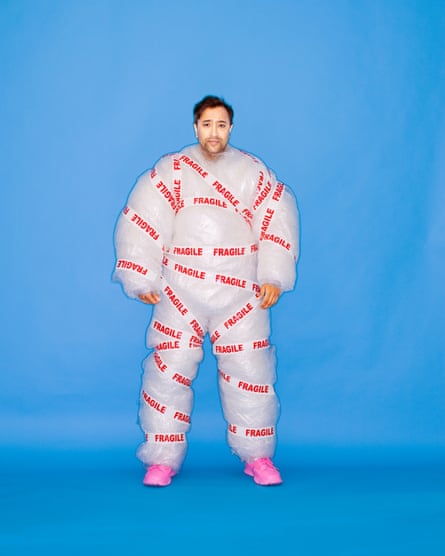
The ‘missing personality type’: could you be a Highly Sensitive Person?
Are you moved to tears by the smallest thing? Do emotions overwhelm you? According to a new book, it may be that you are an HSP just like Nicole Kidman, Lorde and Miranda Hart. Rhik Samadder wonders if he qualifies as one, too
Do strangers sit next to you on the bus and share their secrets? Does art make you cry? Do you feel other people’s feelings? On the other hand, are you prone to being overwhelmed by crowds, bright lights or strong perfume? Bad news – or maybe good. You could be an HSP, a Highly Sensitive Person. The emerging category affects between 15 and 30% of the population, which has some researchers calling it “the missing personality type”.
When I encountered the concept on an Instagram post, I felt both irritated and seen. The checklist was a mirror. I am paralysed by overthinking! Beset by self-doubt! A feelings magnet! Sometimes absurdly so: I once found a chewed-up corn cob on the street, took it home and drew a smile on it. Corny sat on my desk for years and whenever I looked at his brave little face – the face I had drawn – I was moved to tears. When I broke up with my girlfriend, we both cried buckets over custody. I’m thinking she was one, too.
You don’t need a special nose to detect something in the air. The HSP hashtag has more than 498m views on TikTok, while comedian Miranda Hart tweeted: “When I found out I was HSP it truly changed and saved my life.” Lorde, Nicole Kidman and Alanis Morissette have publicly identified as such. Unsurprisingly, Kanye West, too. Quiet people may be sensitive, but sensitive people aren’t quiet any more. After mentioning once that I’m writing about this, my inbox is flooded with strangers sharing their experience. Ironically, it’s quite overwhelming.
Some of it makes me laugh. One correspondent claims their main challenge is: “Every aspect of life! It’s all too much!” Maria, meanwhile, feels other people’s feelings, to the point it makes her sad. But her main problem is “Noises. NOISES.”
“Is it possible you just have feelings, and loud noises… are annoying?” I reply. (Maybe I’m less empathic than I think.)
People identify to varying degrees and for some, it’s simply the most available term. “I didn’t know it was A Thing. Creative people are just more porous. HSP sounds better,” muses bestselling author Jojo Moyes. “It’s helpful not to feel like a weirdo because I worry about the last baked bean left on my plate.”
How can we understand what’s happening inside an HSP? They’ll tell you. That’s a joke; here’s some theory. The term was coined in 1996 by psychologist Elaine Aron, who argued that sensitive brains are uniquely wired to process their environment at a deep level. Her theory’s most striking claim is that physical and emotional sensitivity are one and the same. An intricate attention to body language heightens empathy; responsiveness to subtle physical cues creates rich sensations in HSPs, but can also overwhelm. Scratchy clothes, smells, background talk – unable to filter the noise, they soak up every drop.

Overstimulation is a sensitive’s bête noire. I’m wondering if I qualify. I do react strongly to caffeine and alcohol, so I rarely drink either. I’m often cold. Some noises make me lose my mind. I swear at motorcyclists whom I suspect have modified their exhaust pipes to amplify their revs and I harbour dark fantasies about the feral dogs my neighbours keep in the yard and who bark through the night. But perhaps I react strongly to caffeine and alcohol because I don’t drink them much. For the other example, I could be responding as much to perceived selfishness as noise itself. Plus, it is often cold. HSP? TBC.
A more obvious candidate is my best friend, Victoria. Victoria wells up if asked to picture the internal organs of her cat, so I sometimes do this for a bit of fun. More seriously, I’ve seen her having a panic attack caused by balmy weather. “Heat, cold, hunger or pain… I have a delicate equilibrium, which is easy to upset,” she says. She feels emotions through her whole body, which can leave her nauseous, and she worries that she lacks resilience. Even overlapping conversations at a dinner party are a problem. “I have felt judged by friends and partners not understanding my reactions, or why I have to exit a situation.”
“Sensitivity has a PR problem: we’re accustomed to seeing its downsides,” says Jenn Granneman, one of the writers of a new book on the subject, Sensitive: The Power of a Thoughtful Mind in an Overwhelming World. Co-authored with Andre Sólo, they’re also founders of Sensitive Refuge, described as the world’s largest network of HSPs. Sensitive is synonymous with oversensitive, explains Granneman, and HSPs are often told they should “be less sensitive”. Yet it’s impossible to change the reactivity of one’s nervous system. It’s like trying to be less tall.
Men are particularly vulnerable to the toughness myth, the toxic social message that emotion is weakness, says Sólo. They both identify as HSP now but, as a younger man, Sólo himself was guarded against “feminine” concepts, such as empathy or compassion. “I knew that I read people well, so that’s how I would say it. You re-skin it in different language.”
In the workplace, HSPs are often the highest performers, yet the first to burn out. They can struggle in relationships, as they lean towards people-pleasing. “When you notice all the little hurts that happen with other people, how can you not?” points out Granneman. But the story is not a pessimistic one, she insists. The ability to connect is of huge value and higher sensitivity is linked with creativity, brilliance and higher IQ. The trait is shared by pioneers across science, business and the arts – anyone who notices details others don’t, makes connections they can’t. “I knew an HSP painter who saw 20 different shades of blue on a wall where others saw just one,” she says.
Granneman and Sólo’s rousing book echoes Hannah Jane Walker’s book, which came out earlier this year, also called Sensitive. heir message harks back to Elaine N Aron (author of The Highly Sensitive Person, The Highly Sensitive Parent, etc) whose writing is a clarion call for self-doubters. By accepting their needs, HSPs unlock buried treasure. Researchers use the metaphor of dandelions v orchids: though less hardy, orchids are exquisite. Granneman and Sólo’s first chapter sums it up: “You’re not broken or wrong, because you’re sensitive. The truth is, you have a superpower.”
I hear this exact metaphor used in the pub, by someone who hasn’t read the books. Other people I know are also well aware of their powers. “We’re called hispies in the community,” Ella informs me. Ella has a diverse social circle and always seems to be on a boat, surrounded by male models, even though she works in publishing. “You could have this lifestyle if you were an empath like me,” she writes. I tell her I am an empath and her remark has deeply wounded me. “I’m an empath and your remark has deeply wounded me,” she replies. Touché.
In 2012, Susan Cain’s groundbreaking book Quiet swung a spotlight on to the hidden advantages of introversion. The ground today is different; a related, niche research term can become a mainstream buzzword. There is less shame attached to being sensitive, in some circles quite the opposite. Being neither condition nor disorder, HSP is mostly self-reported. “Labels are a double-edged sword,” says Sólo, who uses “HSP” and “sensitive” interchangeably. “If someone puts a label on you, it’s painful. If you choose one yourself, it’s empowering.” I find myself wondering if this is always true. In a culture of individualism, questioning the merit of self-identification is heresy, but let’s get nuts.
READ RELATED: The Slim-Down Workout You Need at 50 To Get Your Body Back to 40
“Who wouldn’t want to be HSP?” says Fergus Kane, clinical psychologist at the Maudsley, when I throw him the hot potato. “It’s an almost entirely positive set of attributes.” One possible downside, he says, might be missing a diagnosis in another area. Overstimulation overlaps with conditions such as ADHD and autism – female autism in particular is little understood (sensitivity researchers maintain there are key differences) – and a diagnosis might lead to alternative interventions, from meditation to medication. There is a non-clinical value to self-identification, Kane adds, understanding how we interact with the world, and having compassion for ourselves.
Since we’re in the heresies game, let’s try the biggest one. Is HSP real? “It’s unclear whether highly sensitive people warrant their own category – in scientific language, whether the difference is dimensional or taxonomic,” says Kane (whose PhD is in neuroimaging). “There are still few research groups dedicated to this, and a brain study often taken as definitive proof is too limited to generalise its results.” This doesn’t mean HSP isn’t real. All theories look for definitive, areas-of-the-brain-lighting-up proof, one that makes a good picture in the media. But “we can’t really do that with anything to be honest, despite spending billions of pounds on it.”
What is incontrovertible is that the term speaks to people. I hear from a few parents of sensitive children, who struggle with particular fabrics touching their skin or are distressed by playground hubbub. These parents find the term useful as a halfway house between a more serious diagnosis and being told “your child is difficult”. They don’t care about longitudinal studies or sample sizes – they only want to understand their children, and advocate for them.
Does the toughness myth hold any more? In February, the Telegraph revealed that Penguin had employed “sensitivity readers” to remove offensive words from Roald Dahl books, sparking a huge backlash. Some feel sensitive people have been granted an outsize amount of influence. For Granneman, this is a misperception she often comes up against: “A sensitive person may be on board with cancel culture, or against it. It’s not about crying easily, or getting offended.”
Yet there is a generational skew to the wave of interest in HSP. Niche therapeutic terms are ways that Gen Z and younger millennials conceive themselves. “Did you hear my covert narcissism I disguise as altruism?” Taylor Swift sings on Anti-Hero, a line which could come from Robert Waelder or Anna Freud. Infant-attachment theorist John Bowlby would be confused to hear his work is big on dating app, Bumble. In the first season of HBO’s White Lotus, Sydney Sweeney’s character Olivia upbraids her mother for opening doors without knocking, citing her best friend Paula’s HSP. “Who’s her physician? Lena Dunham?” shoots back her mother.
A carousel of conditions revolves online. Via slogans from self-appointed Insta-therapists, it’s become common to claim PTSD, or diagnose people in our lives as narcissists or psychopaths, very rare personality disorders. Emotion reigns supreme – albeit rendered in clinical language. I think this explains my initial flash of irritation. A ubiquitous human trait, like sensitivity – just as with anxiety before it, may now enter an arms race for validation. I don’t mean to attack anyone’s suffering; rather to protect against the erosion of its meaning. As the saying goes, the snowflake does not realise it is part of the avalanche.
Labels can limit, too. We might use them as a reason to stay fixed in old patterns, or not try to overcome inevitable hurdles. Yet they can tell us something. For instance: is there any difference between describing yourself as a highly sensitive person or an HSP? I think so. I think they reveal how much we wish our subjective selves to be grounded in language, neuroscience, consensus. How much we wish to be knowable, even to ourselves. But I believe we are larger than that frame.
Calling myself HSP, HPV or HSBC won’t stop me walking around feeling like an open wound some days. It won’t stop people getting in touch to say how much they disagree with me, or their words being an anvil in my heart for years. And it definitely won’t stop strangers on the bus telling you about their divorce. If it’s any consolation, I feel your pain.
What Being Sensitive Really Means
An extract from Sensitive by Jenn Granneman and Andre Sólo
It began with a simple observation about babies. Some were upset by new sights and smells, while others remained unfazed. In his lab in the 1980s, psychologist Jerome Kagan and his team performed a series of tests on about 500 babies. They dangled Winnie-the-Pooh mobiles before them, held cotton swabs dipped in diluted alcohol to their noses, and projected a face on to a screen that seemed to speak in an eerie synthetic voice. Some babies hardly reacted at all, remaining calm throughout the entire 45-minute session. Others moved constantly, kicking, thrashing, arching their backs and crying. Kagan labeled these babies “high reactive”, while the others were “low reactive” or fell somewhere in the middle. The high-reactive babies, it seemed, were more sensitive to their environment and had probably had this trait since birth. But would this temperament stay with them for life?
Today, we know that it does. Kagan and his associates followed many of the babies into adulthood. Those high-reactive infants, now in their 30s and 40s, have become high-reactive adults. They still have big reactions – they confess to getting nervous in crowds, over-thinking things and worrying about the future. But they also work hard and excel in many ways. Most earned high grades in school, built good careers and made friends just as easily as anyone else did; many were thriving. And many described how they had built confidence and calm in their lives while still preserving their sensitivity.
While Kagan associated this temperament with fearfulness and worry, connecting it to the amygdala (the “fear centre” of the brain), today we know it’s a healthy trait. Dozens of researchers have confirmed this finding, most notably Elaine Aron, arguably the founder of the field of sensitivity research. (In fact, the fearfulness that Kagan observed in some of those high-reactive children largely went away by adulthood.) Now the same trait Kagan studied is known by many names: highly sensitive people (HSPs), sensory processing sensitivity, biological sensitivity to context, differential susceptibility, or even “orchids and dandelions” – sensitive people being the orchids. Recently, there has been a move to bring these theories together under a single umbrella term: environmental sensitivity.
No matter what you call it, sensitivity is defined as the ability to perceive, process, and respond deeply to one’s environment. This ability happens at two levels: (1) perceiving information from the senses and (2) thinking about that information thoroughly or finding many connections between it and other memories, knowledge, or ideas. People who are sensitive do more of both. They naturally pick up more information from their environment, process it more deeply, and are ultimately more shaped by it. Much of this deep processing happens unconsciously and many sensitive people aren’t even aware that they do it.
A better word for sensitive might be responsive. If you are a sensitive person, your body and mind respond more to the world around you. You respond more to heartbreak, pain and loss, but you also respond more to beauty, new ideas and joy. You go deep where others only skim the surface. You keep thinking when others have given up and moved on to something else.
Sensitive by Jenn Granneman and Andre Sólo (Penguin, £16.99) is out now. Buy a copy for £14.95 at guardianbookshop.com
Source: Health & wellbeing | The Guardian








